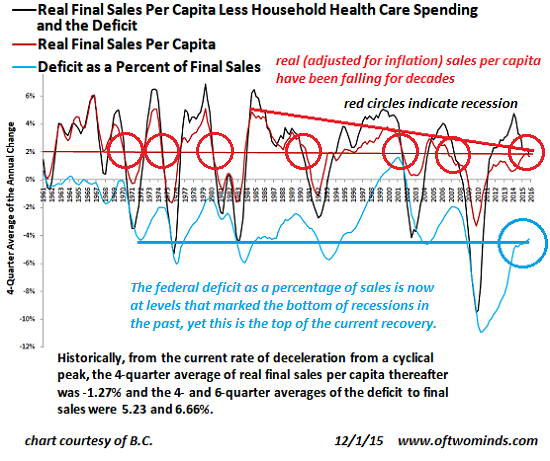There is no escape.
The Census Bureau announced today that total business sales in January did what they’d been doing relentlessly for the past one-and-a-half years: they fell! This time by 1.1% from a year ago, to $1.296 trillion, and by 5% from their peak in July 2014.
They’re now back where they’d been in January 2013. Sales are adjusted for seasonal and trading-day differences, but not for price changes. And since January 2013, the consumer price index rose 2.8%! This is why the US economy has looked so crummy.
That’s bad enough. But it gets much worse.
Total business sales are composed of three categories: sales by merchant wholesalers (33% of total), by manufacturers (36% of total), and by retailers (30% of total).
Sales by merchant wholesalers took the biggest hit: they plunged 6.4% from January a year ago, to $433.1 billion.
Symptomatic for the lousy state of business investment, sales of professional equipment dropped 4.1% year-over-year, with computer equipment and software sales plunging 10.2%. Sales of electrical equipment, the largest category among durable goods, fell 5.0%. Sales of machinery fell 1.4%. And “misc. durable” sales plunged 8.6%.
The economy’s kick-butt, take-no-prisoners winner? Sales of drugs soared 11.0% to $53.6 billion. As we found out today via Express Scripts Drug Trend Report, those sales increases weren’t caused by people suddenly taking more drugs; they were caused largely by price gouging.
Turns out, prices of brand-name prescription drugs soared 16.2% in 2015! One third of these drugs had price increases of over 20%! On average, they’re up nearly 100% since 2011. This is a patent-protected, monopolistic industry that has managed to rip off every consumer and government in the US. And there’s more. Express Scripts:
Moreover, the industry faced opportunistic manufacturers who exploited monopolies with old generic medications and captive pharmacy arrangements, and ongoing scheming by compounding pharmacies to promote sales of high-priced, no-value compound medications.
…click on the above link to read the rest of the article…





